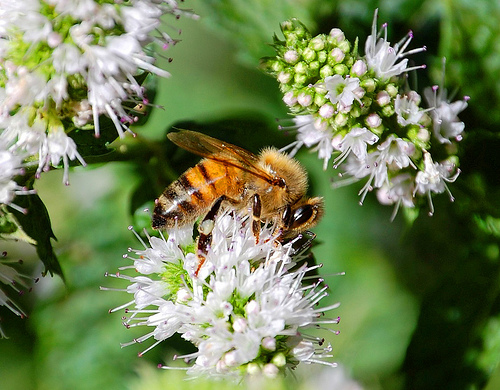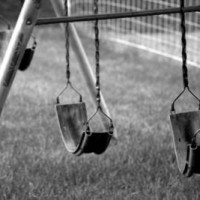
Henry County, Kentucky. When the massive dieoffs of commercial bees first became evident a little less than three years ago, what is now called Colony Collapse Disorder was national news. These days you hear less about it, perhaps because it is no longer a breaking story. Or perhaps we are susceptible to apocalypse fatigue, especially when there has been no apparent decline in the availability of fruits, vegetables and nuts.
The problems continue, though, whether we think about them or not: colonies continue to die off or sicken, beekeepers continue to go out of business, and to the extent we even know what is happening to our native pollinators (the humble bumbles and the like), they too appear to be stressed and declining. Nor are commercial beekeepers the only ones affected; plenty of hobbyists have seen their stay-at-home hives collapse. Last month I asked my local orchardist how his hives were doing, and the answer was Poorly.
In May the Department of Agriculture and the Apiary Inspectors of America (AIA) reported that American beekeepers lost well over a quarter (29 percent) of their colonies from September 2008 to April 2009. That number is down from 36 percent the year before, and 32 percent in 06-07, but it’s still awful. And as the name “Colony Collapse Disorder” indicates, we don’t yet definitively know what’s happening. As Scientific American reported in March, “the growing consensus” is many factors are involved. Hives stressed by poor nutrition, exposure to pesticides and fungicides, and perhaps also cross-country travel weaken and become susceptible to viruses that then destroy them. The bees just disappear.
Rowan Jacobsen’s recent book on the subject (Fruitless Fall: The Collapse of the Honey Bee and the Coming Agricultural Crisis) gives a well-reported and clearly organized discussion of CCD– the theories of its causes, and also what various researchers and some holistically-minded beekeepers are doing to strengthen and save the honey bee. In an email exchange he said he was glad the percentage of lost colonies declined a bit this year, but added that he thinks beekeepers are just getting better at nursing sick colonies. “Basically, they’re keeping more bees alive by moving them to intensive care,” he wrote. “But considering all the extra attention and expense, I found the number of deaths pretty demoralizing.”
Bees have enthralled us for millenia, and not just because of the miracle of honey–though in the centuries before sugar and corn syrup, that intense sweetness would have seemed miraculous enough. They are fascinating animals, a superorganism of instinctive and adaptable behaviors, and they have busied themselves alongside us for a very long time. Since Mr. Jacobsen has written about bees and not just their collapse, his book is full of their capabilities:
* In the 1980’s an entomologist and environmental chemist at the University of Montana named Jerry Bromenshenk trained bees to find chemical pollutants. (This is possible because bees can be trained to track down any odor associated with food.) More recently he has trained them to detect land mines, though this work is secret and he refused to discuss it with Mr. Jacobsen.
* The now-traditional hive used by commercial keepers and most hobbyists in the Langstroth hive, whose comb supers lead bees to create relatively large cells of a single size. But wild bees create comb cells of variable sizes, and the smaller cells seem to help the nurse bees find and destroy the varroa mites that have so plagued American bees since 1987. Hence some hobbyists are turning to topbar hives, which unlike the Langstroth design allow bees to vary their comb size as they choose.
The book has some good news in it as well. A few years after the infestation of the varroa mite, all the wild colonies of escaped honey bees died, but there are some wild colonies now (I heard rumor of one near us in Kentucky a year or two ago). Russian honey bees show more resilience than the more widely available Italian. Taking a less-medicated, let-the-bees-lead route, beekeeper Kirk Webster in Vermont has had success in allowing his bees to breed themselves into better health.
But there is no simple answer. In his quest for a better breed of bee Mr. Webster watched a lot of his colonies die in the process, taking a finanical loss not all beekeepers could or would bear. Also, he is able to segregate his queens in the Green Mountains at breeding time, which is not possible in many other parts of the country. Russian bees are harder to handle commercially than the more mellow Italian. And so forth.
The fact remains that we have overtaxed and overmedicated an animal that is particularly adaptable to living among us, and uniquely valuable. Two years ago Mr. Webster wrote in the American Bee Journal that “[b]eekeeping now has the dubious honor of becoming the first part of our system of industrial agriculture to actually fall apart….We are losing our ability to take care of living things.”
Yet we are so dependent on the bee. One commonly cited estimate is a third of our agricultural production depends on bee pollination, with most of this being done by commercial bees. Such is the case for the California almond crop. Every year in January (as Mr. Jacobsen explains), up to half the commercial bees in the U.S. travel to California to settle in for the almond pollination season in February. Almonds are picky about their climate, but they like California, and so now over four-fifths of the world’s supply is grown there, making almonds a more profitable crop for the state than wine. Two winters back there was fear that this past February there would simply not be enough bees to saturate the groves with the millions necessary to pollinate the nuts. But with the economic tailspin, a glut of almonds from the year before, and a drought that took acres of trees out of production, Mr. Jacobsen says there were more than enough bees even with continuing CCD losses. In fact, prices for hive rentals were down and it was a bad financial year for the beekeepers who service the almond groves.
All of this means the ultimate victims of this crisis may not be the bees. While a Black Death is culling huge numbers of them, it doesn’t appear we are in danger of honey bees becoming extinct. We may be watching the extinction of the professional American beekeeper, however. (“We can’t stand another bug or virus or pest,” is what the president of the American Honey Producers Association told Mr. Jacobsen.) You can put a beehive nearly anywhere, just as you can grow vegetables nearly anywhere, but without the experience and the willingness to tend to these our smallest herd animals–and without enough of the gypsy bees moving from field to field of monocrops, from which most of us still eat–well, barring significant changes in the way we farm, sooner or later we may find that muskmelons have become luxury goods even in July. We take our summer largesse for granted, but then we have long taken bees for granted, and now we can’t.





11 comments
Dale Nelson
Something that some folks might consider: if you own property and have some waste area, e.g. by an alley, see if you can establish local wildflowers there. I live in North Dakota. In recent years I gathered seeds from mayweed (Matricaria recutita, I think) and golden glow (Rudbeckia laciniata) plants growing in alleys and a wooded area a few block from my house, and scattered them in appropriate places on the property. The plants don’t need watering or any type of care. My Audbon field guide says mayweed can be a skin irritant, but this type, at least, doesn’t seem to cause any problem. Both plants have attractive flowers — attractive to bees, too. I also find that bees like hollyhocks, which grow well here.
Laura
Alas, in the case of CCD, that is unlikely. That is one way to interpret the swarming instinct perhaps. Not on strike so much, as striking out for new territory. Here in the west backyard beekeeping is on the rise, and I figure every new beekeeper’s lost swarm is another chance for the feral colonies to reestablish themselves, at least that is how I looked at it when I lost half of my first colony.
If this post has you feeling low, remember you can always garden organically and plant flowers, shrubs and trees that are good nectar and pollen sources for pollinators of all stripes, and that bloom from early spring through late fall. If you must use pesticides herbicides and fungicides (and really, you mustn’t), use them at times when you will be less likely to impact the pollinators (i.e. when the plants are dormant or before they bloom). Keep in mind too that highly hybridized plant varieties often are poor sources of nectar and pollen (the bee’s protein source for raising healthy brood), so consider open pollinated and heirloom varieties, as well as setting aside corners of your property just for insectaries, or plantings specifically for beneficial insects.
vera
Any chance the bees are on strike and leaving for the wild, never to return?
Katherine Dalton
The honey bees appear, as far as we can tell, to be stressed by recently introduced diseases, whose worldwide spread is fostered by modern trade and travel, and by pesticides and fungicides, which are modern methods of dealing with the wrong bug or fungus in the wrong spot by modern farming’s requirements. So to this extent, modernity (as you put it) is indeed responsible for the current level of stress bees are showing. Modernity is us, of course.
Agriculture is hard to predict, because so many factors are involved. We will weather it somehow, but what will “weathering” mean? As I said, it doesn’t yet appear we will lose honey bees as a species, but the financial losses commercial beekeepers are trying to weather may put them out of business. If we then get a handle on CCD, and it becomes profitable for beekeepers to go back into business, I expect some would, or some hobbyists would turn professional.
But we do not have a handle on CCD yet, and what happens to agriculture in the years it takes the beekeepers to rebuild? What if it’s not profitable for them to rebuild? We can import honey, and we can import still more of our fruits and vegetables while transportation is relatively cheap and easy, and while pollinators are still working in other sections of the globe, but we can’t import pollination. Personally I’d hate to be ever-more dependent on Mexico, South America and China for many crops, and I don’t think it’s prudent, either. That’s a long road from field to stomach. I am not wise enough to predict the future broadly or otherwise. But every American farmer who throws in the towel I regret–I am certain of that.
Grass is wind pollinated, and needs no bee, so whatever CCD ends up costing us we’ll still have wheat, corn, and corn syrup (barring any troubles there). Perhaps for many of us that’s variety enough.
Carl Scott
Good to get an update on this. Thanks. Interesting that modern science stil hasn’t cracked the case. But even if 5 or so factors emerge as the most likely key, we should be able to weather through, right? I don’t rule the syndrome out as an unindentifiable by-product of the modern market system, composed of factors so complex no science could ever capture it, but I don’t assume such a causality and thus blame modernity as such.
And it seems at least possible to me, that all modernity aside, that tomorrow an unforeseen and unforeseeble bacteria might develop, bringing our system crashing to the ground somehow.
Jus’ sayin’ that until the science on this hive disorder gets clearer, we don’t really know what its broader implications for our modern way of life are. Right?
Katherine Dalton
I agree about the photo; taken by Steve W. Lee in Hayward, CA, who was generous enough to share it via the internet.
We see through the bees, darkly, Prof. Peters? I think so too.
JD Salyer
“While a Black Death is culling huge numbers of them, it doesn’t appear we are in danger of honey bees becoming extinct. We may be watching the extinction of the professional American beekeeper, however.”
Food, shmood. Who needs beekeepers when you got management compliance testers, senior business measurement analysts, and vice presidents of product marketing?
More seriously — Ms. Dalton is right-on. This is clearly yet another one of those things Modern Man tends to ignore until it’s too late. Then he ignores the root reason for the problem by joining a “progressive” movement.
Not to worry, our Dear Leader will probably dole out a heaping helping of public funds to various eco-corporations that will promise to rescue the bee.
“Bees have enthralled us for millenia…”
As a little trivia aside, in Plato’s *Meno*, the bee is used as a symbolic stand-in for virtue … Socrates asks his young friend Meno to answer the question, “What is the nature of a bee?”
Much like our over-simplifying techno-utopians of today, Meno at first assumes he knows the answer to what had seemed to be an easy question.
Bob Cheeks
Perhaps the most important essay published here. The prospects are truly frightening; I do hope you continue to keep us informed.
D.W. Sabin
Having just started Hector St. John Crevecoeur’s “Letters From an American Farmer”, I was treated to two episodes early in the book. First, Crevecoeur’s “Farmer Citizen” discusses the process of attracting wild bees to a bait and staining them with Vermillion… and with compass and experience, tracking the bees to their forest hive so as to bring some of them back to work in the farmers fields. It was but one of many “chores” this farmer enjoyed. Secondly, in an astonishing bit, the Farmer discusses bringing a paper wasp nest into his home and mounting it high in his parlor to act as predators on the abundant flies….some of them even alighting on his child’s eyelids to nab a fly. He speaks of their aggressiveness but asserts they are of great benefit if treated with respect. This bit of folk wisdom comes on the heels of a local woodsman informing me that I should not be so paranoid about the extremely aggressive White Faced Hornet because they are effective hunters and killers of the Carpenter Bees that infest my wood soffits.
From mites to this new mysterious decline, the bees here are reduced but seem to be holding their own. We continue to essentially disregard the fate of all manner of both wildlife and domestic animals that furnish us with our sustenance but this is of no surprise at all because we insist upon murdering ourselves with continuing vigor. They various die-offs and extinctions seem to add another note of the distinctive Greek Chorus singing our funeral oration but we continue to turn a deaf ear.
That is a spectacular photograph!
Dale Nelson
Barth (whom I haven’t read) seems to have backed away a bit from that characterization of the analogia entis as the work of antichrist:
http://books.google.com/books?id=OkDS5QKqXEIC&pg=PA180&lpg=PA180&dq=%22analogia+entis%22+barth+antichrist&source=bl&ots=wgs_pkZCqT&sig=lsDgnJi7wyo_LoLACTW7UptifNA&hl=en&ei=0FqNSsfgFYWAswO9lIjxCQ&sa=X&oi=book_result&ct=result&resnum=5#
Jason Peters
I’ll get in trouble for this, no doubt, but one of the advantages of a pre-modern notion of ourselves and of the world is that it is often a better explanatory tool than the modern ones. Alexander Pope carried such a notion into the 18th century: “From nature’s chain whatever link you strike / Ten or ten thousandth breaks the chain alike.”
But then he was foolish enough to buy the old cosmology and the analogia entis and all that rubbish.
Karl Barth, who was mor prolific than profound, said that the analogia entis is the work of anti-christ and the best reason for not becoming a Catholic. More recently David Bentley Hart, who so far is more profound than prolific, has said that rejecting the analogia entis might be the work of anti-christ and quite possibly the best reason for not becoming a protestant.
Ecclesiastical wars aside, bee news over the last few years has put me in sympathy with Pope and Hart and reminded of what a foolish thing it was to suppose we could abuse some parts of the world so long as we preserved others.
An interesting and welcome, if grim, post, for which thanks.
Comments are closed.